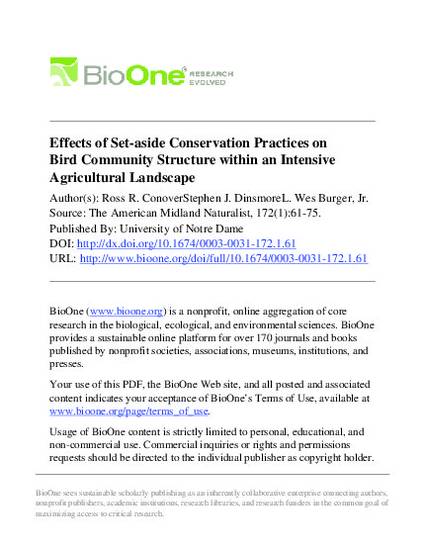
Creating and restoring patches of noncrop early-succession vegetation within agricultural landscapes may mitigate grassland bird population declines caused by agricultural land use and intensification. Achieving this goal requires an ability to balance avian benefits with agronomics, which may be facilitated by understanding how bird communities respond to various conservation practices. We evaluated bird richness, abundance, Shannon diversity, and Total Avian Conservation Value in 20 replicates of four Conservation Reserve Program practices in an intensive rowcrop agricultural landscape in the Mississippi Alluvial Valley from May–Jul., 2005–2007. Conservation practices included: (1) large blocks of structurally-diverse early-succession vegetation (6–8 y old trees) and three buffer types; (2) 30 m wide monotypic filter strips with tall dense switchgrass (Panicum virgatum); (3) 30 m wide diverse filter strips with a forb-native warm season grass mixture; and (4) 60 m wide early-succession riparian forest buffers (1–3 y old trees). The breeding bird community was dominated by red-winged blackbirds (Agelaius phoeniceus; 43% of total) and dickcissels (Spiza americana; 42% of total) but commonly included eastern meadowlarks (Sturnella magna), indigo buntings (Passerina cyanea), mourning doves (Zenaida macroura), and northern bobwhite (Colinus virginianus). We observed ≥1.8 × more dickcissels in large blocks and diverse filter strips than other buffers and greater Shannon diversity in large blocks than any buffers (P < 0.05). Diverse filter strips had ≥1.6 × greater overall bird density (7.2 birds/0.6 ha), on average, than all other practices. Based on these data, we conclude that buffers are attractive to farmland breeding birds and may provide important ecological benefits to supplement a conservation management system founded on large blocks of early-succession vegetation.
Available at: http://works.bepress.com/stephen_dinsmore/71/

This article is from American Midland Naturalist 172 (2014): 61, doi:10.1674/0003-0031-172.1.61. Posted with permission.